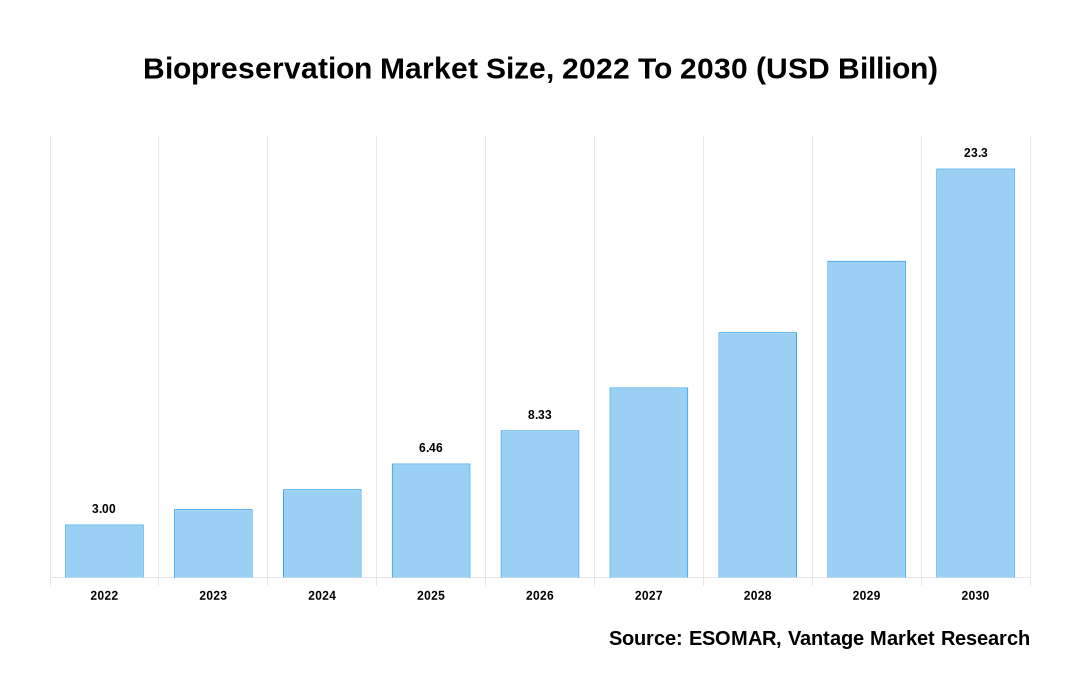Global Biopreservation Market
As stated in our extensive report, the Global Biopreservation Market accounted for USD 3 Billion in 2022 and is projected to reach a value of USD 23.3 Billion by 2030.
Cells, tissues, and organs can all be preserved and stored as part of the Biopreservation industry for later use. Biopreservation techniques are used to maintain the integrity of these samples and prevent degradation and spoilage. The increasing demand for preserved biological samples in various fields, including healthcare, research, and pharmaceuticals, drives the Biopreservation market. Biobanks, which collect and store biological samples for analysis, are a significant user of Biopreservation techniques. The market is also driven by technological advancements in preservation techniques, such as cryopreservation, which involves freezing biological samples at extremely low temperatures. This technique enables long-term storage of samples and is widely used in fields such as regenerative medicine and transplantation.
The Biopreservation market encompasses the safeguarding and storing of biological samples, encompassing cells, tissues, and organs, with the intention of future utilization. Biopreservation methodologies are employed to uphold the integrity of these samples, preventing their deterioration and spoilage. The demand for preserved biological samples across diverse sectors, including healthcare, research, and pharmaceuticals, is a key driver for the Biopreservation market. Notably, biobanks that amass and retain biological samples for research constitute a significant user group for Biopreservation methods. Technological progressions in preservation techniques, such as cryopreservation—entailing the freezing of biological samples at exceptionally low temperatures—are another driving force. This approach facilitates the prolonged storage of samples and finds extensive utility in domains like regenerative medicine and transplantation.
Click To Get a Free Sample On the Research Study

Key Factors Influencing Global Biopreservation Market Growth
The growth of the global Biopreservation market can be attributable to the following:
- There is a growing need for long-term storage and preservation of biological samples, such as tissues, organs, cells, and stem cells, for research and therapeutic purposes. Biopreservation offers a solution for maintaining the quality and viability of these samples.
- There has been a significant increase in research and development efforts in biotechnology and biopharmaceuticals as a consequence of a growing number of chronic illnesses like cancer, cardiovascular disease, and diabetes. This drives the demand for Biopreservation technologies to store and preserve biological samples used in drug discovery and development.
- The development of advanced Biopreservation techniques, such as cryopreservation, vitrification, and hypothermic storage, has improved the efficiency and effectiveness of preserving biological samples. These technological advancements have attracted significant investments from research institutions and biobanks, further driving market growth.
- With an emphasis on creating cutting-edge treatments employing stem cells and tissue engineering, the area of regenerative medicine is quickly advancing. Biopreservation is crucial in storing and preserving these valuable therapeutic materials, supporting the market’s growth.
- Biobanks are important repositories of biological samples and data, serving as a valuable resource for research and development activities. The expansion of biobanking facilities and the increasing number of collaborations between biobanks and research institutions contribute to the growth of the Biopreservation market.
North America Region to Express the Largest Market Growth
The North America market is accounted to have the most significant market growth in 2022. This growth can be attributed to a well-established healthcare infrastructure, encompassing advanced medical research institutions, pharmaceutical companies, and biotechnology firms. These entities are pivotal in generating substantial demand for such technologies to underpin their research, drug discovery, and clinical pursuits. Furthermore, North America boasts a robust network of biobanks, encompassing initiatives funded by the government, academic biorepositories, and private biobanks. These biobanks are instrumental in collecting and storing an extensive array of biological samples for research and clinical purposes, making them significant consumers of these technologies. A mature infrastructure and adherence to standardization practices within North American biobanks further enhance the region’s commanding position within the market.
Conclusion
Overall, the Biopreservation market is poised to experience substantial expansion driven by heightened requests for cutting-edge preservation methodologies, the escalating incidence of chronic illnesses, technological progressions, investments in regenerative medicine, and the augmentation of biobanking infrastructure.
Some of the key players in the Global Biopreservation Market include- BioCision LLC (U.S.), BioLife Solutions Inc. (U.S.), Cesca Therapeutics Inc. (U.S.), Core Dynamics Ltd. (U.S.), Custom Biogenic Systems Inc. (U.S.), Lifeline Scientific Inc. (U.S.), Merck KGaA (Germany), Princeton CryoTech Inc. (U.S.) to mention a handful.
![[Market Research Reports] – Research Google News Blog | VMR.Biz](https://www.vmr.biz/wp-content/uploads/2022/12/logo-removebg-preview.png)











